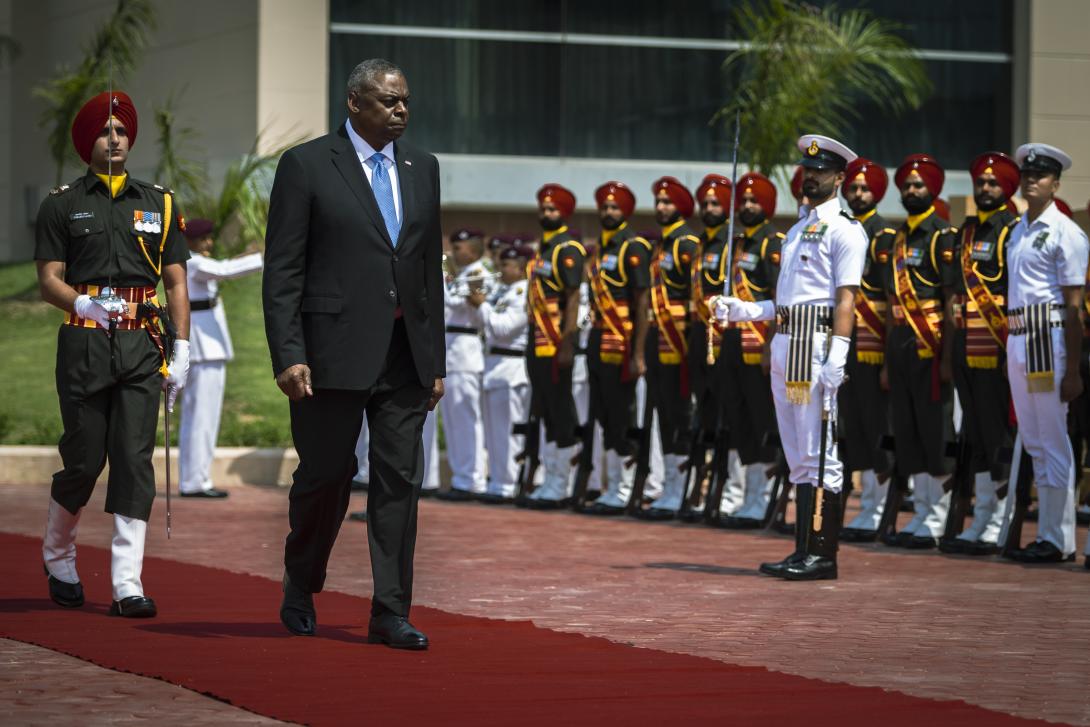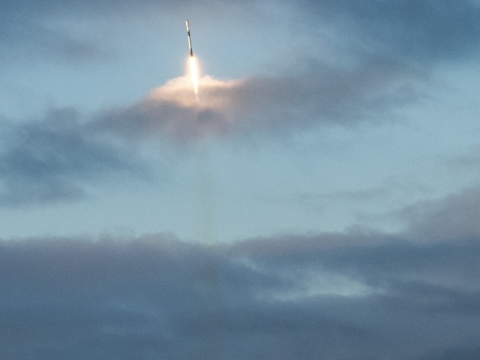The United States Takes Unprecedented Steps With India
The U.S. Indo-Pacific Command’s primary objective, through deterrence, is to prevent a war in the Indo-Pacific region. To perform this mission on the military front, its commander, Adm. John Aquilino, USN, relies on a-whole-of-U.S.-government approach to diplomacy, information, military and economic foreign policy measures. The command, known as INDOPACOM, is constantly broadening its relationships across the incredibly vast region, since what is at stake is the international rules-based order set up after World War II to preserve stability and generate prosperity for countries around the world.
“That rules-based order is very much under threat right now and is being challenged in many different countries by the People’s Republic of China and Russia,” said David Ranz, INDOPACOM senior foreign policy advisor. A 30-year diplomat in the Senior Foreign Service as a minister counselor, Ranz joined the command in August of 2022 to advise Adm. Aquilino.
And while the United States has five treaty allies in the region—Korea, Australia, Japan, Philippines and Thailand—India is quickly emerging as an important partner, more so than ever before. “I’ve been working very, very closely on and with India for the last five years in a row,” Ranz shared, having previously served as the U.S. consul general in Mumbai and the deputy assistant secretary of state for South Asia (for India, Bangladesh, Nepal, Sri Lanka, Bhutan and Maldives) in the State Department’s Bureau of South and Central Asian Affairs. Previously, he was the deputy assistant secretary of state to Pakistan.
“And what I’ve often said is that when the history books of the 21st century are written, the chapter on U.S.-India relations is almost certainly going to be the most important. It is critically important for international global stability and for maintenance of the international rules-based order that the United States and India continue to work closely together.”
Ranz pointed to several reasons why America and India are now forging stronger ties. First, India is amongst the few countries in the Indo-Pacific region with the military and economic potential to serve as not just a regional leader but a global leader, he said. In addition, India has surpassed China as having the largest population in the world. And the United States and India are the oldest and the largest two democracies in the world. “So, we have significant natural affinities that result from that,” Ranz offered.
As such, the United States is partnering with the South Asian nation across all areas. “There is no area of human endeavor with which we do not partner with India right now,” he emphasized. “The pace and growth of our relationship across every domain—it is truly extraordinary. And all you need to do is take a look at the most recent visit of [India’s] Prime Minister [Narendra] Modi to Washington and look at the summary of things that were agreed to. [In September, U.S.] President [Joe] Biden headed to Delhi for the G-20 summit.”
These presidential-level visits have prompted steps to “deepen and diversify” the two countries’ so-called Major Defence Partnership, with expanded cooperation in new and emerging domains such as space and artificial intelligence and accelerated defense industrial collaboration.
One example of the heightened defense collaboration is the June agreement by the United States for GE Aerospace to pursue manufacturing fighter jet engines in India for Indian Air Force’s Tejas Mk2, the single-engine, super fighter light combat aircraft. Under the memorandum of understanding signed by India’s Hindustan Aeronautical Limited—and pending the commercial negotiations and receipt of the necessary export authorizations following the August 29 completion of the U.S. congressional notification process—GE would co-produce 99 GE F-414 jet engines with their country.
The White House defined the arrangement as an “unprecedented co-production and technology transfer proposal.” Meanwhile, the head of GE and GE Aerospace, H. Lawrence Culp Jr., called the measure “a historic agreement,” one that would be “a key element in strengthening defense cooperation between the two countries.” Ranz, who noted that the two countries already have significant military-based co-production efforts, sees this latest step as “a major advancement in our military, industrial cooperation with India.”
In addition, India will purchase 31 U.S. MQ-9B Reapers from General Atomics, 16 SkyGuardian and 15 SeaGuardian versions of the remotely piloted aircraft and ancillary equipment, the White House said. Given the unmanned aerial vehicle’s intelligence, surveillance and reconnaissance capabilities, the measure “would advance a significant area of important cooperation between the U.S. and India, that of maritime domain awareness,” Ranz noted.
The two militaries have signed their second Master Ship Repair Agreement, with the U.S. Navy and Mazagon Dock Shipbuilders Ltd., in August 2023, recommitting to advancing India’s emergence as a hub for the maintenance and repair of forward-deployed U.S. Navy assets and other aircraft and vessels, according to the White House. The countries also made further commitments for U.S. companies to invest more in India’s maintenance, repair and overhaul capabilities and facilities for aircraft.
In late September, Ely Ratner, the U.S. Department of Defense’s assistant secretary of defense for Indo-Pacific Security Affairs, co-chaired the so-called U.S.-India 2+2 Intersessional Dialogue. With Ranz in attendance, alongside Donald Lu, the Department of State’s assistant secretary of state for South and Central Asian Affairs; Vani Rao, a secretary in the Indian Ministry of External Affairs; and Indian Ministry of Defense Joint Secretary Vishwesh Negi, the dialogue advanced “a wide range of ambitious initiatives” between the two nations.
Topics included defense and security efforts, emerging technologies, relationships, clean energy and supply chain resilience. Building on the “transformative momentum” of the partnership, Ratner also reviewed the progress the two countries have made on implementing the Roadmap for U.S.-India Defense Industrial Cooperation and GE’s and other new co-production initiatives. “They also discussed opportunities to further strengthen interoperability and logistics cooperation, including through combined maritime engagements in the Indian Ocean region, as well as expanded cooperation in the space and cyber domains,” according to a DoD statement. “The officials also discussed regional security developments and strategic priorities across the Indo-Pacific region. A strong U.S.-India partnership is essential to upholding security and prosperity in the Indo-Pacific region.”

It is no surprise that the countries that are seeking to overturn that order are among the most powerful countries that would like a system where they define the rules and everybody else just has to bow to their will.
INDOPACOM is also closely following the two countries’ new INDUS-X effort, the India-U.S. Defense Acceleration Ecosystem collaboration designed to leverage innovations from the U.S. and Indian defense sectors that specifically address shared security challenges. The effort held an inaugural start-up partnership meeting in India through academic partners IIT Kanpur and the Pennsylvania State University, the White House reported. In addition, U.S. accelerator M/s Hacking 4 Allies (H4X) held a joint accelerator program for nascent Indian companies during a workshop at IIT Hyderabad in August. Also, the Indian Ministry of Defence’s Innovations for Defence Excellence and DoD’s Defense Innovation Unit will launch two joint challenges with start-ups to develop defense solutions for shared military technology gaps.
“It is a greater DoD effort, but we certainly follow it with great interest because anything that advances the U.S.-India security relationship and advances our two countries’ military-industrial efforts is going to be of great value to INDOPACOM at some point,” Ranz said, speaking of INDUS-X.
Activities of the so-called Quad nations, part of the Quadrilateral Security Dialogue with India, Australia and Japan, also remains important to INDOPACOM, especially as venue for those governments to address China’s territorial claims, illegal fishing and overreach in the region. India is set to host the 2024 meeting of the Quad nations, the White House also reported.
“The Quads’ primary programming is nonsecurity, nonmilitary,” Ranz clarified. “But there’s one interesting sort of security-oriented initiative called the Indo-Pacific Partnership for Maritime Domain Awareness Initiative where the Quads are taking unclassified commercially available maritime domain awareness information and making that data available to our partners and allies throughout the Indo-Pacific. For South Asia, India is taking the lead; for Southeast Asia, the U.S. is taking the lead. And in the Pacific, Australia is taking the lead. India has a significant maritime presence and has very long borders on both the West and East and in the Indian Ocean where there is a vast amount of area to monitor. India is very interested in expanding its maritime domain awareness capabilities. And we’re working closely with them on that with the Quad partners and other partners as well.”
Additionally, a more notable step is the anticipated arrival of Indian liaison officers at INDOPACOM, Ranz added. This common practice places foreign officers at U.S. combatant commands and posts U.S. liaison officers at key military establishments abroad with partners such as the United Kingdom, Canada, France, Australia, New Zealand, Philippines, Korea, Japan and others.
“We really look forward to having an Indian liaison officer here at INDOPACOM that will help provide that connective tissue between us and our partners,” Ranz said. “We already do a significant amount of exercising with India. And obviously, the more interoperable we are and the greater we are able to show a commonality of view on a free and open Indo-Pacific in the rules-based order, the better it will be for preserving security.”
With India, “it’s a relationship of immense potential,” Ranz stated. “There are always going to be challenges. We don’t agree with them on everything, but we don’t agree on everything with Canada or the United Kingdom. So we’re not going to agree on everything with India either, but the trajectory of the relationship [is extraordinary]. For those who have been following India closely, if you would have predicted even five years ago that we would be where we are now, I think the most optimistic people would not have predicted how far we’ve come in that relationship. And I see huge advancements coming up in the next couple of years.”




Comments